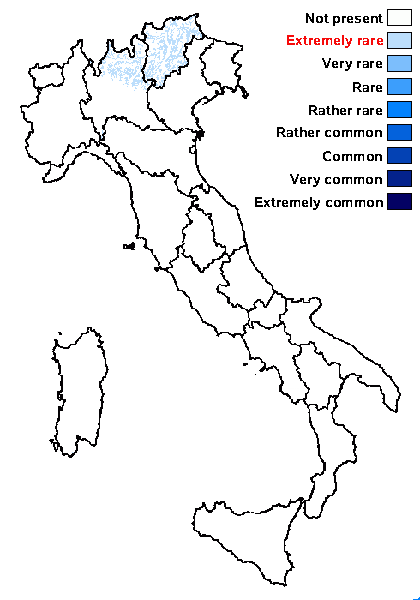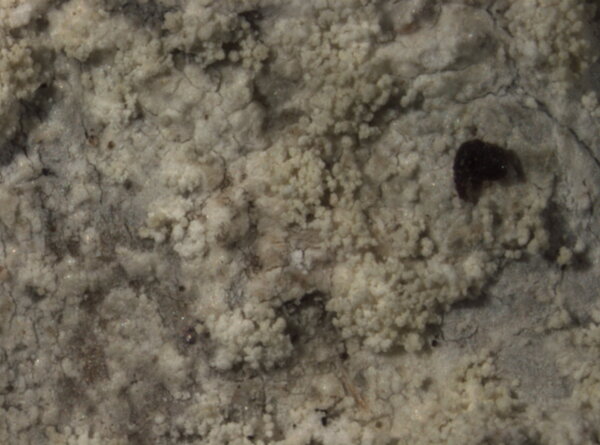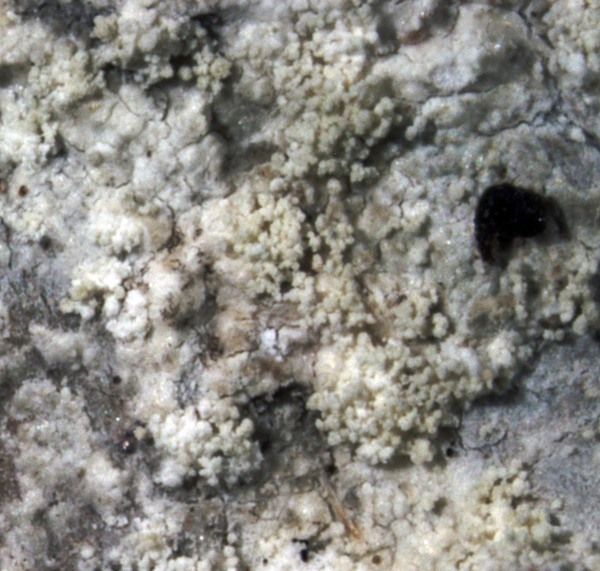Megalaria pulverea (Borrer) Hafellner & E. Schreiner
in Schreiner & Hafellner, Bibl. Lichenol., 45: 146, 1992. Basionym: Lecidea pulverea Borrer in Hooker & Sowerby - Engl. Bot., Suppl. 2: tab. 2726, 1834.
Synonyms: Biatora commutata (Ach.) Rabenh.; Biatorina commutata (Ach.) A. Massal.; Biatorina pulverea (Borrer) Mudd; Catillaria incana H. Olivier; Catillaria pulverea (Borrer) Lettau; Catillochroma pulverea (Borrer) Kalb; Catinaria pulverea (Borrer) Vězda & Poelt; Pertusaria miniescens Erichsen
Distribution: N - TAA (Nascimbene & al. 2007b), Lomb (Ravera & al. 2022b).
Description: Thallus crustose, episubstratic, forming irregular, up to several dm wide patches, continuous and granulose-sorediate, usually without a distinct prothallus or with a thin, whitish prothallus. Soralia greyish green, bluish green or yellowish green, mostly diffuse, irregular, at first often scattered on a thin thallus, later tending to form a thick, often cracked subleprose crust. Soredia mostly coarse, (20-)30-50 μm in diam., often gathered into globose, subcylindrical to subcoralloid, up to 140 μm thick consoredia. Medulla white, distinct in well-developed specimens. Apothecia rather rare, lecideine, bluish black, 0.5-2.5 mm across, with a flat to slightly convex, often contorted disc and a thin proper margin. Exciple colourless or pale brown in upper part, of anticlinally arranged hyphae; epithecium dark green, K+ intensifying green, N+ red, sometimes with additional violet, K+ green patches; hymenium colourless, 45-80 μm high, I+ pale brown; paraphyses thick-walled, 1.5-2.5 μm thick, the apical cells clavate and swollen, 3-4 μm wide, surrounded by dark pigment; hypothecium colourless to pale brown, K-, with crystals not dissolving in K. Asci 8-spored, cylindrical-clavate, with a K/I+ blue apical dome penetrated by a narrow, K/I- apical cushion surrounded by a narrow, deeply K/I+ blue zone, the wall K/I- but surrounded by an I+ red-brown and K/I+ blue outer layer, the ocular chamber small, Biatora-type. Ascospores 1-septate hyaline, fusiform-ellipsoid, thick-walled, 10-19 x 4.5-6.5 μm. Photobiont chlorococcoid, the cells 5-15 μm wide. Spot tests: thallus K+ bright yellow (sometimes turning brown-red), C-, KC+ or KC+ pale yellow, P+ rust-red or P– or P+ faintly yellow, UV-. Chemistry: atranorin, zeorin, usually fumarprotocetraric acid, plus sometimes protocetraric acid, and several terpenoids and unidentified fatty acids (traces).Note: a cool-temperate lichen found on bark and mossy trunks of deciduous trees and Abies in old, humid, montane woodlands. According to Printzen (1995) the ascus of Biatora-type and other anatomical characters do not support the inclusion of this species into Megalaria, but here I adopt a broad concept of the genus, following Fryday & Lendemer (2010).
Growth form: Crustose
Substrata: bark
Photobiont: green algae other than Trentepohlia
Reproductive strategy: mainly asexual, by soredia, or soredia-like structures (e.g. blastidia)
Most common in areas with a humid-warm climate (e.g. most of Tyrrenian Italy)
Commonnes-rarity: (info)
Alpine belt: absent
Subalpine belt: absent
Oromediterranean belt: absent
Montane belt: extremely rare
Submediterranean belt: absent
Padanian area: absent
Humid submediterranean belt: absent
Humid mediterranean belt: absent
Dry mediterranean belt: absent

Predictive model
Herbarium samples
Growth form: Crustose
Substrata: bark
Photobiont: green algae other than Trentepohlia
Reproductive strategy: mainly asexual, by soredia, or soredia-like structures (e.g. blastidia)
Most common in areas with a humid-warm climate (e.g. most of Tyrrenian Italy)
Commonnes-rarity: (info)
Alpine belt: absent
Subalpine belt: absent
Oromediterranean belt: absent
Montane belt: extremely rare
Submediterranean belt: absent
Padanian area: absent
Humid submediterranean belt: absent
Humid mediterranean belt: absent
Dry mediterranean belt: absent

Predictive model
| Herbarium samples |
 Index Fungorum
Index Fungorum
 GBIF
GBIF





